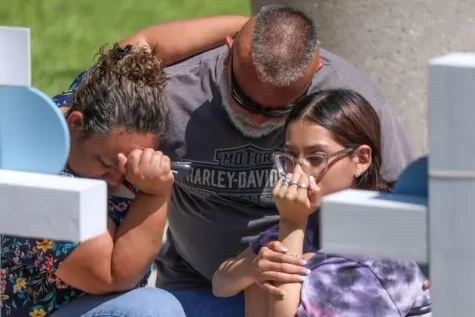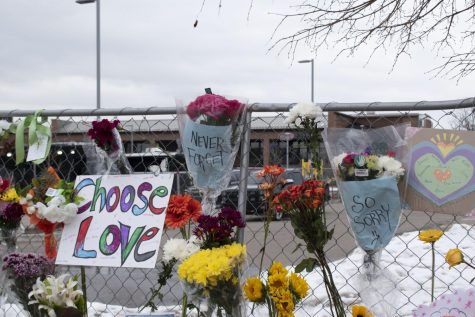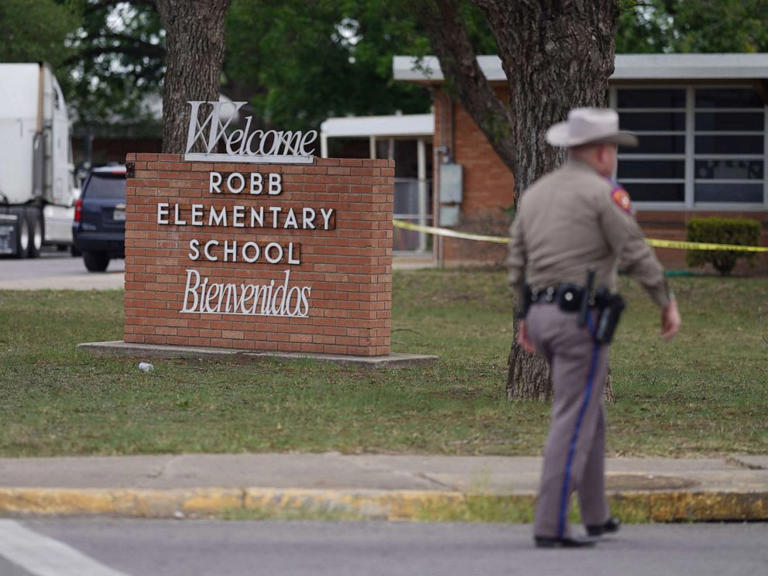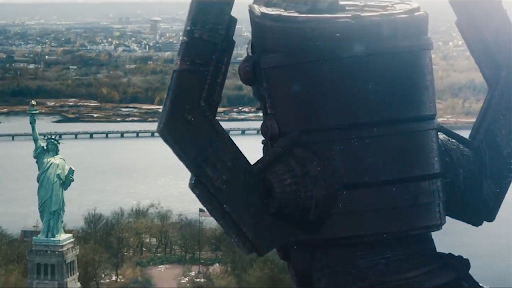No End in Sight
Last Tuesday, tragedy struck in Texas as our country experienced the deadliest school shooting since Sandy Hook. Little has changed since then, and the problem of gun-violence in America only seems to be getting worse.
Allison Dinner/AFP via Getty Images
A police officer walks in front of Robb Elementary in Uvalde, TX.
No matter how many lockdown drills we practice, nothing can ever really prepare us for the prospect of having to escape a classroom through windows broken by police. Nothing can prepare us for the moment our principal declares that “this is not a drill” over the intercom. Last year, on May 27th, this reality was closer than ever on our campus. On the last day of school, Eaglecrest was put on lockdown as a non-Eaglecrest student, rumored to have a gun, attempted to enter the building. The bell rang, marking the beginning of summer break, as we remained in our classrooms, texting our parents and friends, hoping that we would make it to May 28th. The current state of our world leaves students, parents, and educators questioning the safety of schools each day. This reality is a failure of our government and our society — a failure that resulted in Tuesday’s tragedy in Uvalde, Texas.
Around 11:30 a.m., an 18-year-old gunman opened fire on a classroom at Robb Elementary School, murdering 19 children and 2 teachers, and injuring several others. The shooter legally purchased an AR-15 style semi-automatic rifle shortly after his eighteenth birthday and days before the tragedy. Although his motive remains unknown, it has been reported that he was bullied for a speech impediment, the clothes he wore and his family’s socioeconomic status. He also posted threatening messages on social media, including images of his newly purchased weapons, before the attack.
Tuesday’s events mark the twenty-seventh school shooting in 2022 and the second mass shooting just within the last ten days. We are overwhelmed with feelings of disgust, anger, and disappointment. This shooting has stimulated an already-intense fear within all of us.

Several of our Nest Network staff members have younger siblings who are the same ages as the victims of Tuesday’s attack. Unfortunately, kids around the country do not need much explanation of what happened. Since preschool, they have had countless lockdown drills to the point where they can understand the reality we are living in, even as nine and ten-year-olds.
“My younger sister is 10, the same age as countless victims of the massacre. She is bubbly and bright, and she isn’t blind to what is happening in the world,” one NN staff reporter wrote. “There are times that she has told me that she hasn’t wanted to go to school, or was very stressed about the idea of danger in the building. It is heartbreaking to hear her childlike wonder be stripped away by the potential violence present in schools. Schools themselves are places where children should blossom socially, creatively, and mentally, but the fear of a mass murderer minimizes this experience.”
These kids, instead of focusing on being kids, are worrying about the important safety precautions and procedures they must follow to stay alive. Of course, these procedures are important, but we need to be doing more. Thoughts and prayers are important, but they will not prevent this from happening again. This year alone, it has been proven 213 times that we are not doing enough. How many innocent children, teachers, first responders, grocery shoppers, friends, brothers, or mothers have to die for people to act? Saying that there is a problem is one thing. Unless we want to wake up to another stream of notifications outlining the 214th mass shooting this year, we must take real steps towards reform.
It starts small. Mass shootings are often motivated by past bullying, humiliation, and trauma. While being a victim of bullying is no excuse to take innocent lives, we should all try to be kinder to the people around us. As individuals, we may not be able to change laws and regulations. But we can be more compassionate towards others, regardless of their race, ethnicity or socioeconomic background one has. Simple acts of kindness can have a much larger impact than we think — turning around someone’s “bad day” can save lives.
Unfortunately, the solution to issues of mass violence is far more complicated than showing kindness. Mental health is also closely linked to many violent acts, like mass shootings. According to John Hopkins Medicine, about 1 in 4 adults suffer from a diagnosable mental disorder in a given year. As mental health becomes increasingly prevalent, resources have come into question. Especially after instances of mass violence, our community must ask itself: how can we help those who need it. Colorado seems to always get looped back into these discussions because of our devastating history with mass shootings, like the Columbine, STEM School and Boulder tragedies. As a more progressive state, Colorado has seen the need for mental health reform. Now, access to resources is better than ever. Colorado recently introduced “I Matter,” a statewide program that provides teens with up to six free counseling sessions without requiring parental consent. And, the Cherry Creek School District is in the process of opening a mental health day facility that will provide care for students in our district. These are both incredible new resources that you can go to for help. Improving access to mental health support is only one step we need to take toward decreasing gun violence.

Not every state or community sees adequate access to these services. Often, therapy is not covered by health insurance, and the process of finding a therapist is not an easy one. Accessing services through health care can take hours of phone calls and research — time that few people have to spare. Expanding programs like “I Matter” to teens and adults across the nation and streamlining processes that block access to mental health services can make therapy available to everyone, which can be a powerful tool in decreasing acts of mass violence in our country.
As a high school publication, our priority in this conversation are attacks on other schools. School security played a major role in Tuesday’s attack. According to NBC News, Robb Elementary had an extensive safety plan, but the gunman was able to evade security personnel, entering the school through an unlocked door. One of our Nest Network reporters has a younger sibling in elementary school. In a more well-funded school district like ours, security procedures are intense: You cannot open the doors without being buzzed in. Then you must sign into a sheet with a valid ID and the location you will be visiting. Inside this front office, there is bulletproof glass in case of an active shooter situation. After signing in and showing identification, you must be buzzed in multiple times to get through to the school itself, and there are buttons hidden behind the glass that instantly shut the doors to the classrooms.
Having proper safety procedures can make a difference in situations like these. All schools should be able to receive proper funding and support to put these measures into action. School can already be a high tense and stressful environment, murderers getting through should not even be a thought in a child’s mind.
Even despite mandated lockdown drills and emergency procedures, all it took was one open door for 21 people to die. This attack was preventable, as school shootings often are. Socioeconomic factors, such as income level, population, and race have a significant impact on the amount of funding a school can get for safety features. Generally, an area that has low-income levels and a low population may not have the means to have the extensive security that can make a difference in situations like these. Underresourced communities often do not have the funding that is needed for the buzzers, cameras and other equipment. This was not the case at Robb Elementary, though; the Uvalde school district spent $450,000 on security in the 2019-2020 school year. Ultimately, the perpetrator was able to enter the building unchallenged through the unlocked door, and there was no school resource officer available at the time. Robb Elementary may have had enough buzzers and cameras, but the attack could have been prevented with more security personnel or more exhaustive security routines.
Police response is also a significant aspect of what occurred on Tuesday. However, investigations regarding the exact timeline of the attack are still ongoing.
In general, the most action against school shooters has been taken at the local level: increased mental health services, tighter security and more education. But, we seem to be struggling to agree on the national level. Despite all the lives lost, voters and politicians have their left/right party blinders on, when what we should be prioritizing are the innocent victims of these sickening crimes.
Although it is unrealistic to completely remove guns from society, there has to be more regulation to prevent more violence.
Background checks are necessary to own a gun, but they should go beyond criminal history and mental health history. The perpetrator of the shooting in Uvalde had a criminal or mental health record, hence his ability to purchase his rifle just days before the massacre. This background check clearly was not enough to stop the tragedy. Background checks should ensure that guns do not end up in the wrong hands. A comprehensive social media check should added to standard background checks.
Before attacking, most school shooters post threatening or violent messages on social media. Investigating a person’s social media, just like college admissions offices and employers do, helps reveal the character and intentions of a person. Certain types of posts, comments or likes could be “flagged.” For example, liking or posting sadistic messages could be a “flag.” Then guidelines, such as a certain number of flags, could prevent certain people from purchasing firearms.
In Colorado, concealed carry permits must be renewed every five years. The problem with that is that, in five years, many things can change: a person’s job, mental health, home or financial situation may be very different. Major life events could affect their outlook on life. In the case that those thoughts become violent, because someone already owns a gun with a valid permit, it will be even easier to attack others. To prevent this from happening, the period of validity for a gun permit could be shortened to two years. By requiring renewal more often, it will be easier to catch people who may no longer be fit to carry a gun.
Finally, the age requirement for obtaining a gun should be raised. Currently, you only need to be eighteen years old to own a gun, yet you cannot even legally drink alchohol at that age. The two most recent mass shootings in the U.S. — one in Buffalo, NY and the other in Uvalde, TX — were perpetrated by eighteen-year-old males. Males between the ages of fifteen and 24 make up the majority of school shooters. Rasing the age limit for the legal purchase of a gun seems to be one of the few viable solutions to the issue of gun violence in America.
Even after there have been more shootings than days in 2022, our questions remain unanswered. Every shooting garners a similar response: shock, thoughts and prayers, empty promises of change. Then it happens again. Something needs to change. No one has all the answers, but we have lost too many people to continue the same narrative. Our country must find a way to meet in the middle; partisan agendas are consistently prioritized over children, a choice that will likely threaten the future of our country.






